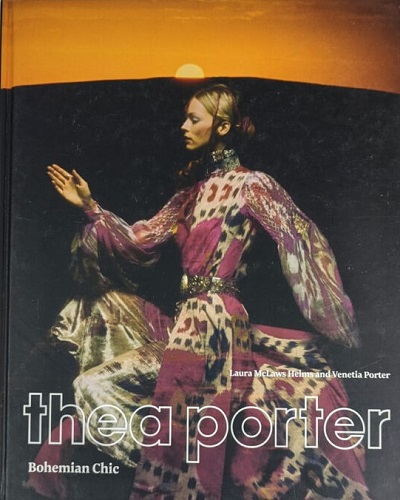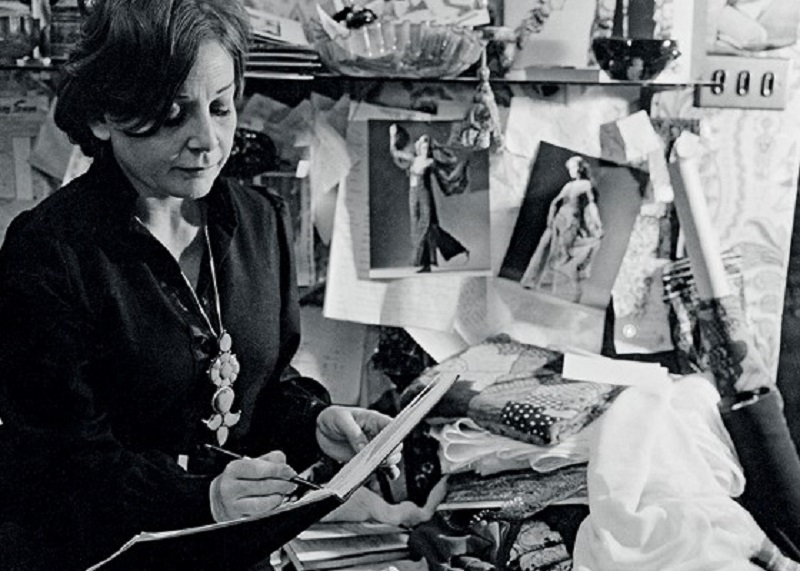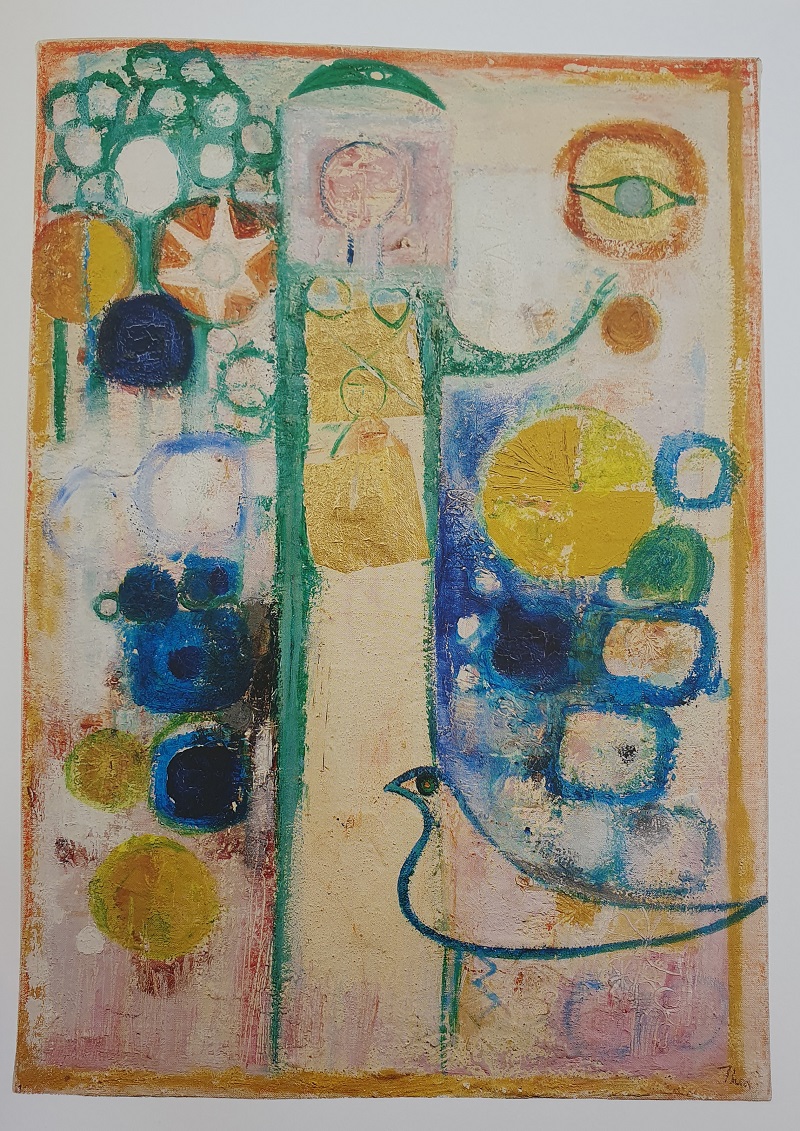Once, towns strewn across Turkey and Afghanistan owed their economies to the western appetite for the kaftan. During the 1970s travellers on the hippy trail brought back pottery, soft furnishings, and piles of clothes to remind them of their spiritual adventures.
More than 40 years on, the kaftan has had several revivals as a key fashion piece. And, like Indian cuisine, it now seems to have been adopted as a British staple. It is the late Thea Porter, who is credited with bringing the bohemian look to London catwalks.
Although Thea Porter is not as famous a name as Mary Quant or Laura Ashley, her influence on the look of her era is just as potent. Her loose, draped shapes and fabrics helped create the style of stars such as Faye Dunaway and Elizabeth Taylor in the 1970s, and they have since become forever entangled with the idea of rock-star self-indulgence.
Excerpt from article on Acnauta Couture website
This is a short overview of Thea Porter’s work and career based on the book Thea Porter Bohemian Chic by Laura McLaws Helms and Venetia Porter. The book was published in 2015 and accompanied an exhibition at the Fashion and Textile Museum in London.
Early Years
Dorothea Noelle Naomi Sigel was born in Jerusalem in 1927 and grew up in Syria. As a child, she was inspired by her mother’s ‘unsatisfied longing for luxury’. Thea remembers how she accompanied her mother on visits to Suz Al-Hamidieh, the covered bazaar in Damascus.
“Trailing after her I learnt about the spices and condiments, about the bewildering variety of sweetmeats… about ice cream scented with mastic and pistachios… but also about fabrics and trimmings and buttons, and lace’ about gold, bangles and precious stones; about perfumes, scents and essential oils.”
Thea moved to England after WW2 to finish high school and to study. It was where her awareness of clothes, fashion, and dress blossomed and she often wrote letters to her mother describing the fashion she’d seen in the streets and the outfits she chose for herself.
Beirut Influence
Beirut during the 1950s and 1960s was known as the Paris of the Middle East. Newly married, Thea and her husband’s social circle included politicians, journalists, and artists, and they enjoyed travels to Iran, Iraq, and Jordan. Clothes played a huge part in her life and she prided herself in ‘being the best-dressed embassy wife’.
Thea immersed herself in her social life, and surrounded by creative friends, she explored her creativity with art lessons culminating in four exhibitions between 1961 and 1963.
“Her paintings were abstract and full of colour’ she worked on paper and on canvas, often using collage, mirror and gold leaf.”
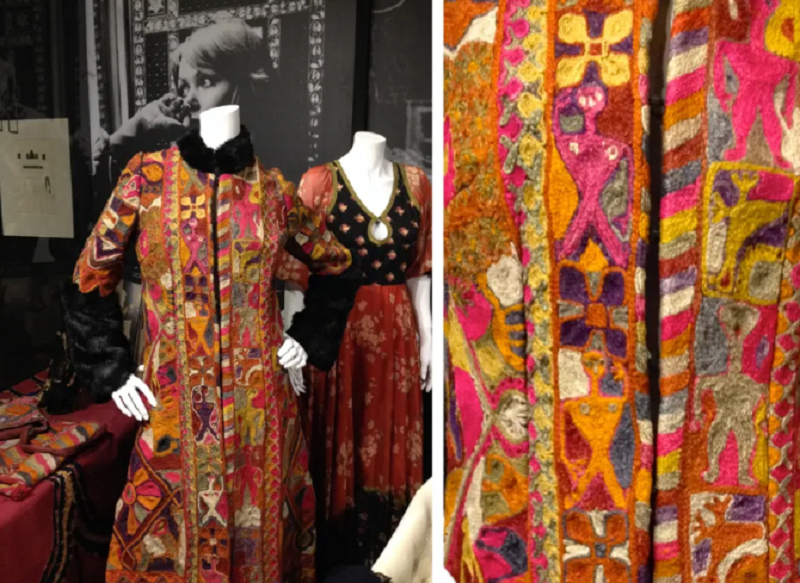
coats on display in the Greek Street Shop. Made from an Iraqi samawa carpet. Photo credit: www.maudeinteriors.com
From Interior Design to Fashion Design
In 1964, Thea left both Beirut and her marriage and moved to London where she worked to establish herself as an interior designer.
The uniqueness of Porter’s life experience and personal style offered her novel ways in which to blend traditional Arabian craftsmanship with Orientalist taste, and apply this new aesthetic in modern European homes. Thea Porter Decorations Ltd opened on Greek Street in Soho in 1966 just as the boho and hippy aesthetic became fashionable.
“Porter was in a unique position – she could interpret authentically this Western fascination with Middle Eastern cultures, and hence offer chic Londoners an expertly curated, highly styled sampling of wearable traditional Middle Eastern heritage.”
For Thea, the line between home décor and fashion was blurry and she comfortably used ‘the same fabrics on women, chairs, and walls’. Beyond upholstery fabrics, Thea also found success producing a shirtdress made from embroidered tablecloths made in Damascus. Thea’s career as a designer spanned many decades and saw her conquer the catwalks, fashion magazines, and the imagination of both celebrities and the public with her exotic sense of style.
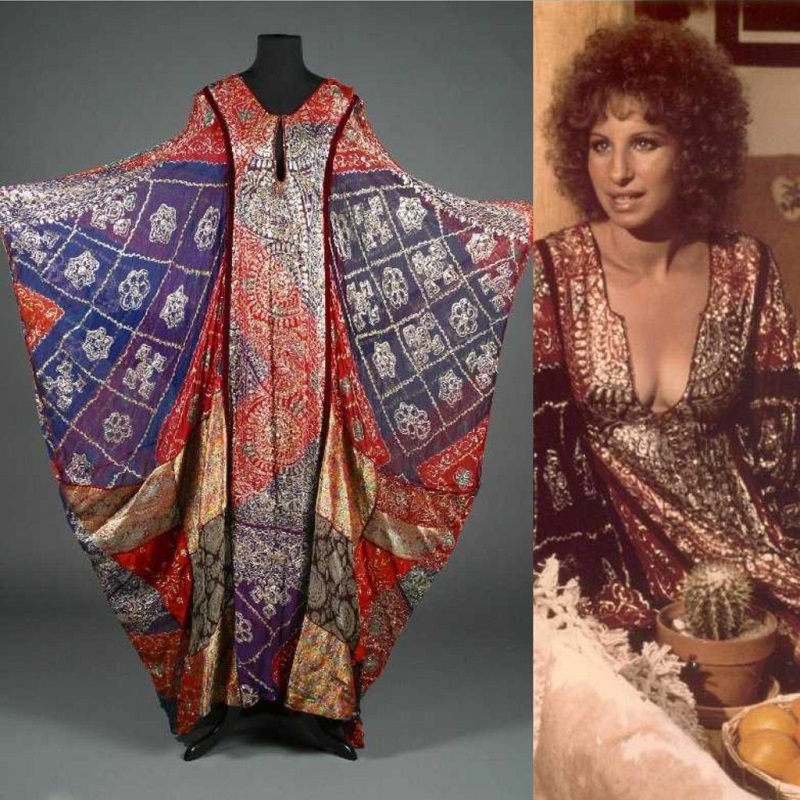
Thea Porter kaftan worn by Babara Streisand in A Star is Born, 1976. Image credit: www.streisandstylefiles.com
Seven Signature Styles
These were not only her best-selling styles but the ones that Thea had the greatest affinity for. We will look at the three styles most closely influenced by Arab dress heritage, in more detail.
- The Thawb* or kaftan
- The Gipsy dress
- The Faye dress
- The Brocade panel dress
- The Wrap-over dress
- The Chazara Jacket
- The Sirwal skirt
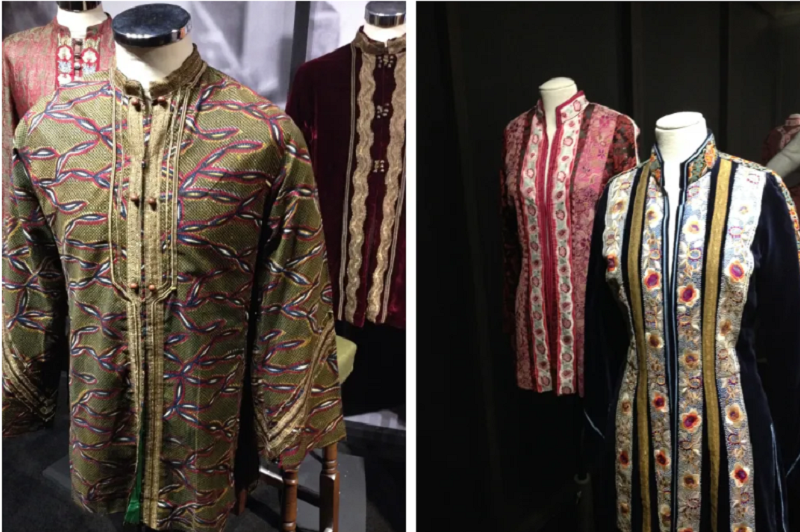
Djellaba style tunic top from African batik and Chazara jackets featuring gold brocade and velvet. Image credit: www.maudeinteriors.com
The Thawb* or kaftan
The best known of all Porter’s signature styles is based upon the thawb (mistakenly called an abaya by Thea Porter, in the book, and in general in the western lexicon) often described as a kaftan or djellaba in museum collections or at auctions.
The influx of various Middle Eastern or North African traditional garments into Western Europe in the 1960s, brought back from the hippie trail, resulted in any vaguely Arabic-looking robe being referred to as a kaftan… Porter’s attraction to the abaya* lay in its enveloping fabric. “I’ve always felt very envious of Arab women because they can hide behind their clothes. It is a very protected and secure way to feel.”
At least 25 versions of Porter’s abaya* dress were made with remarkable commercial success. They were popular for their ability to hide the body beneath the billowing folds, with transparent fabrics hinting subtly at the female form.
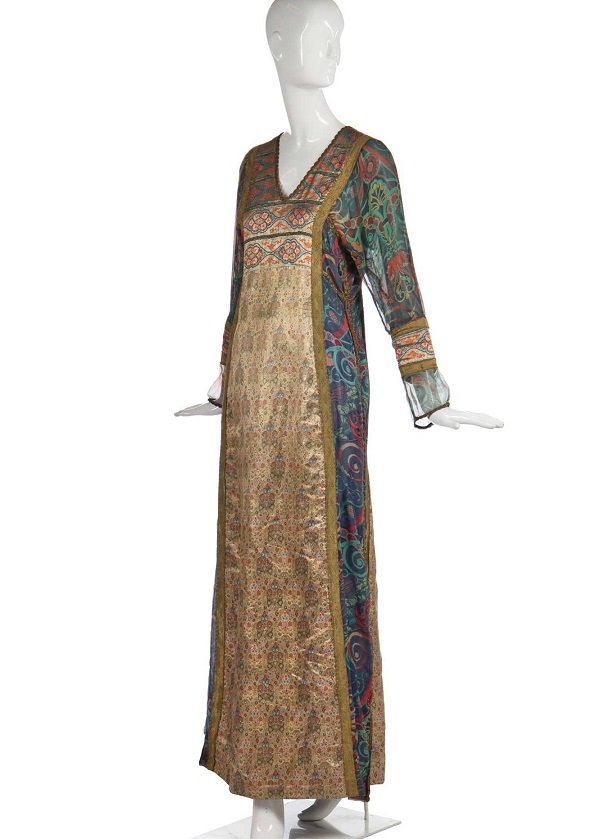
A Thea Porter printed chiffon dress with a central brocaded panel, 1970s. Image credit: www.kerrytaylorauctions.com
The Brocade panel dress
The play between masking and revelation also appeared in this style of dress. A long slim dress with brocade panels front and back, with see-through sides, the brocade edged with a thin braid or ribbon. First produced in 1971 and was popular with western socialites.
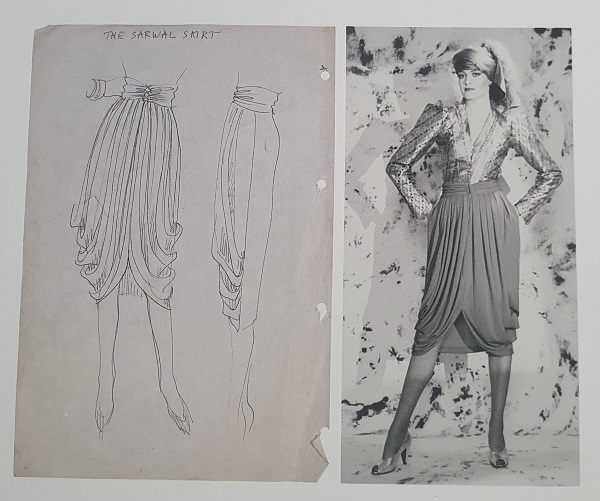
In her Autumn/Winter 1982 collection, Thea Porter contrasted the sirwal skirt with a brocade jacket and matching turban. Photographer Van Pariser. Image from book.
The Sirwal Skirt
drawing on the traditional sirwal – baggy pyjama-like trousers worn in Arabian countries, Porter interpreted it into a tightly-waisted skirt with voluminous draped folds that fell either to the knee or the ankle. “With a silhouette reminiscent of harem odalisques in Orientalist paintings, this skirt bridged the gap between fantasy and modernity”. It was made from jersey and was easy to wear and pack, therefore particularly appealing to Porter’s jet-setting clientele.
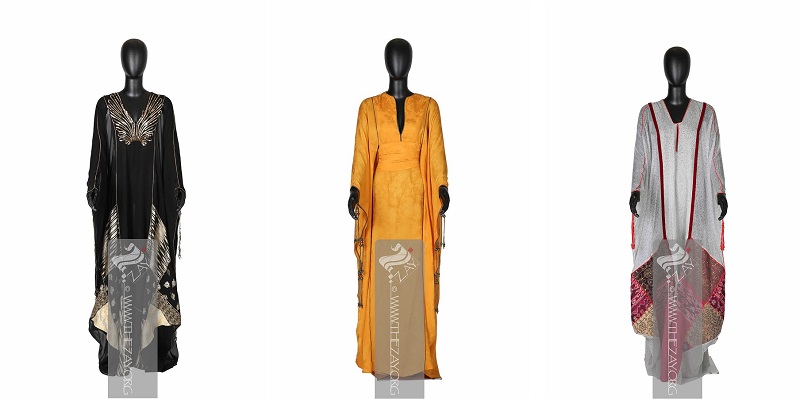
Three Thea Porter garments in The Zay Collection. Left: ZI2022.501001.1 UK; Middle: ZI2022.501001.2 UK; Right: ZI2022.501001.3 UK
In The Zay Collection
Dr Reem el Mutwalli acquired three items designed by Thea Porter from Kerry Taylor Auctions in 2022.
This Thea Porter black silk chiffon overgarment (thawb) is couture-labelled (Thea Porter Couture). The overall shape follows the style of overgarments (athwab) commonly found in different areas of the Arabian Gulf and Iraq. Composed of a central body panel sandwiched between two wide and full-length sleeve panels. A patchwork of (lamé) panels resemble stylised depictions of the gussets (bitan) found on more traditional thawb versions, and form the décorative focus of the article, together with the yoke that is adorned in hand-embroidered gold and silver sequined rays. Tailoring lines and sleeve openings are edged with gold metallic braid (gitan) and two tassels (‘amayil) on each side, resembling those found on men’s outer cloaks (‘ibi). Moyra Swan is famously photographed wearing a similar thawb – with panels of identical silver and gold, art-deco patterned lamé – at Topkapi Palace, Istanbul, for British Vogue, November 1971 (photographed by Barry Lategan).
This Thea Porter marigold-orange damask silk overgarment (thawb) is unlabelled. The overall shape follows the style of overgarments (athwab) commonly found in different areas of the Arabian Gulf and Iraq. Composed of a central body panel sandwiched between two wide and full-length sleeve panels. Since it self-ties with a wide waistband and has a plunging V-neckline, when worn, it visually resembles a hybrid look, a combination of both an overgarment (thawb) and a Japanese kimono. The tailoring lines, neckline and sleeve openings are all edged with gold metallic braid (gitan) and four tassels (‘amayil) on each side, resembling those found on men’s outer cloaks (‘ibi).
This couture labelled (Thea Porter Couture), sheer silk, overgarment (thawb), is of white ground, printed in small repetitive butterfly motifs. The general shape follows the style of overgarments (athwab) commonly found in different areas of the Arabian Gulf and Iraq. Composed of a central body panel sandwiched between two wide and full-length sleeve panels. The V-neck opening is simple and devoid of any elaborate embellishment. Patchwork panels of antique (Ikat) silk, Indian sequined velvet, and shocking pink (tussah) silk, resemble stylised depictions of gussets (bitan) found on more traditional thawb versions, forming the décorative focus of the article. Main tailoring lines are trimmed with scarlet silk cord and burgundy velvet ribbon bands both at the front and back end. While sleeve openings are edged with matching red silk braid (gitan) and two tassels (‘amayil) on each side, resembling those found on men’s outer cloaks (‘ibi).
The Book
Title: Thea Porter – Bohemian Chic
Authors: Laura McLaws Helms and Venetia Porter
Publisher: V&A Publishing
ISBN: 978-1-85177-826-3
Hardcover
160 pages
Text and images on a white or black background
English
